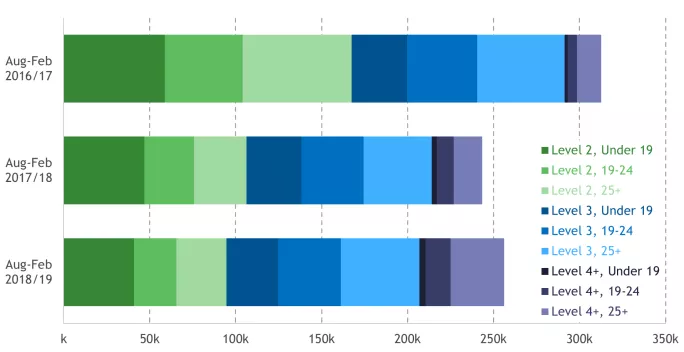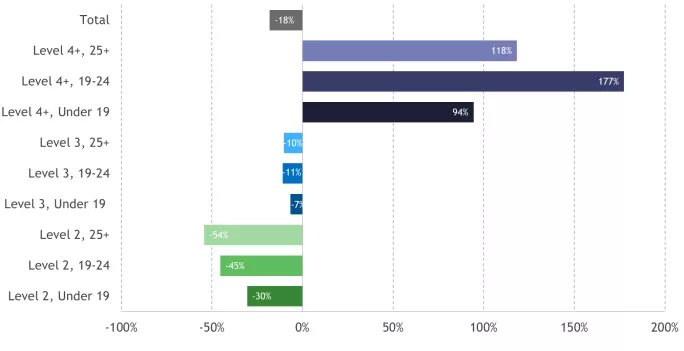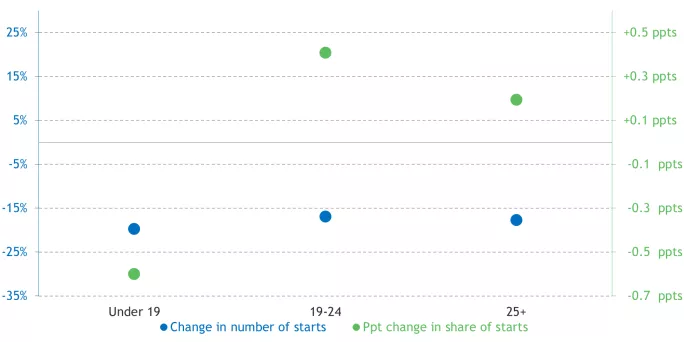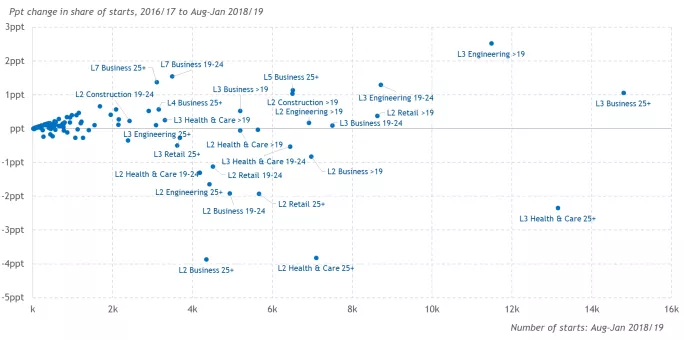
- Home
- ‘The system is failing those not going to university’
‘The system is failing those not going to university’

Today we got the latest figures for the apprenticeship starts - and a big motivation for why reforms were needed in the first place with the publication of the Social Mobility Commission’s latest state of the nation report.
One of the key findings of the report was that post-16 education, rather than acting as a vehicle for greater social mobility, is failing far too many young people who aren’t taking the traditional route to university. It’s through this lens that we should view the latest apprenticeship trends.
Read more: Commission calls for 16-19 student premium
More news: ‘A degree of confusion over apprenticeships’
Background: University’s apprenticeships ‘require improvement’
Fewer starts overall
The latest Department for Education figures show that 25,300 apprenticeships were started in February of this year, down 4 per cent on the preview year. The new post-levy apprenticeship system appears to have stabilised - fewer starts overall, and with a big shift in the composition of courses.

The two most notable changes we’ve seen since the launch of the apprenticeship levy have been a reduction in the number of lower-level starts and rise in the number at levels 4+ (i.e. higher-education equivalent programmes). Compared to August to February 2016-17, the number of level 4+ starts has almost doubled for under-19s , and almost trebled for those aged 19-24.

The rise of level 4+ courses under the levy shouldn’t be too surprising - levy-payers tend to be larger firms, many of which operate in professional sectors that demand higher-level qualifications. Presented with a ‘use it or lose it’ training fund, you’d expect them to opt for programmes that are tailored to the educational profile of their pre-existing staff. But this new pattern brings with two key challenges: money and age.
Push towards higher-level apprenticeships
First, money: higher-level apprenticeship training tends to more expensive. Courses last longer, require more expensive equipment and facilities, and highly-paid trainers (e.g. university lecturers and other highly-qualified staff). The push towards higher-level apprenticeships inevitably puts a squeeze on the overall apprenticeships budget, which in turns limits support for apprenticeship training among smaller, non-levy paying firms.
To some, this doesn’t look like a problem: many of the level 2 apprenticeships that characterised the pre-levy system were low-quality programmes that offered little skills development. Higher-level programmes, particularly those that offer young people a genuine platform for development, should be welcomed. But herein lies the second challenge: age.
Since the levy and its wider reforms came into play, both the overall number and the share of starts taken up by under 19s has fallen. The system looks less focused on young people than in the past. This is largely out of step with the education secretary’s call for apprenticeships to be a core post-16 option for young people.

Young people
There are some encouraging signs. As figure 2 showed, the number of higher-level starts taken up by young people has risen, with 3,500 starts between August and February 2018/19. But this growth is dwarfed by the growth in the number of 25+ apprentices starting higher-level programmes over the same timeframe: 31,000. Despite the promise (and warm words for) degree apprenticeships, there were more than twice as many older apprentices starting MBA-level equivalent programmes than there were young people starting a degree apprenticeship route.
Figure 4 plots the number of apprenticeship starts in more detail by breaking them down by sector. Again, there are encouraging signs amid these wider warnings - a large and growing number of level 3 engineering apprenticeships taken up by the under 19s for example.

And yet, much of the growth has taken place at higher-levels for older apprentices: level 7 (Master’s equivalent) business programmes for those 19-24 and 25+, level 5 business programmes for 25+. This mixed picture is perhaps the inevitable consequence of a programme that’s been hoped to achieve a number of (sometimes) competing aims: boosting productivity and responding to (large) employer’s demands while also providing young, often lower-qualified, people with a route into skilled employment.
Turning back to today’s Social Mobility Commission, and indeed the Resolution Foundation’s research, it is painfully clear that our further education system is failing too many young people who don’t go to university. The government is right to be pushing apprenticeships as a route to better serve lower-qualified younger people, and should boost apprenticeship funding for this group. But if levy funds are continually channelled towards (more expensive) higher-level routes for older apprentices, there will be fewer resources to fund programmes either at lower levels or catered towards the young. The big risk is that apprenticeships replicate, rather than address, the ‘haves and have nots’ problem with our wider education system.
Kathleen Henehan is research and policy analyst and Stephen Clarke senior economic analyst at the Resolution Foundation
Register with Tes and you can read five free articles every month, plus you'll have access to our range of award-winning newsletters.
Keep reading for just £4.90 per month
You've reached your limit of free articles this month. Subscribe for £4.90 per month for three months and get:
- Unlimited access to all Tes magazine content
- Exclusive subscriber-only stories
- Award-winning email newsletters
You've reached your limit of free articles this month. Subscribe for £4.90 per month for three months and get:
- Unlimited access to all Tes magazine content
- Exclusive subscriber-only stories
- Award-winning email newsletters